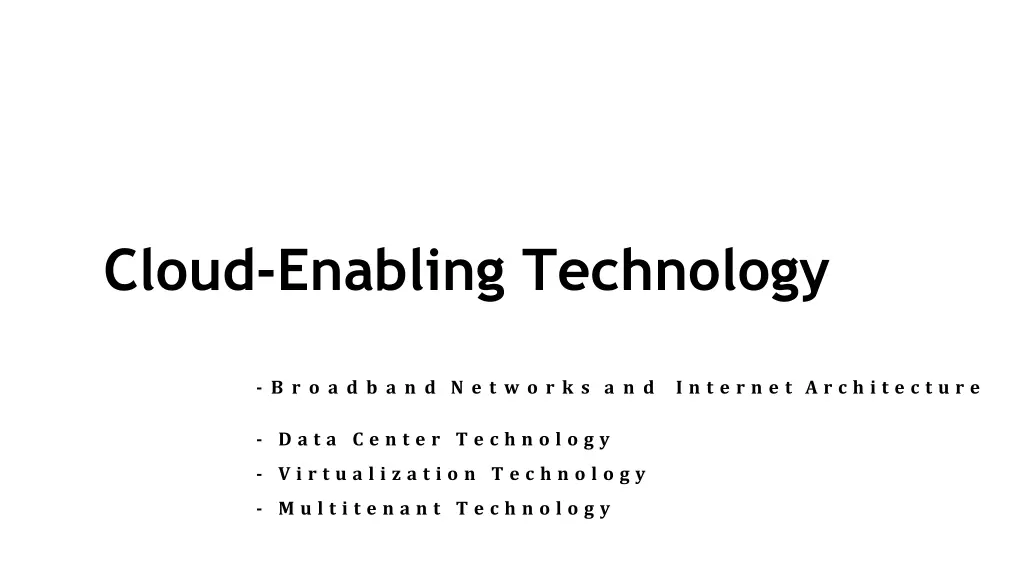
Cloud-Enabling Technology and Data Center Innovation
Explore the intersection of cloud-enabling technology, broadband networks, internet architecture, data center technology, virtualization, and multitenant solutions. Learn about the crucial role of broadband networks, connectionless packet switching, and grouping IT resources in data center technology. Understand the benefits of virtualization in optimizing IT infrastructure for enhanced efficiency and accessibility.
Download Presentation

Please find below an Image/Link to download the presentation.
The content on the website is provided AS IS for your information and personal use only. It may not be sold, licensed, or shared on other websites without obtaining consent from the author. If you encounter any issues during the download, it is possible that the publisher has removed the file from their server.
You are allowed to download the files provided on this website for personal or commercial use, subject to the condition that they are used lawfully. All files are the property of their respective owners.
The content on the website is provided AS IS for your information and personal use only. It may not be sold, licensed, or shared on other websites without obtaining consent from the author.
E N D
Presentation Transcript
Cloud-Enabling Technology - B r o a d b a n d N e t w o r k s a n d I n t e r n e t A r c h i t e c t u r e - D a t a C e n t e r T e c h n o l o g y - V i r t u a l i z a t i o n T e c h n o l o g y - M u l t i t e n a n t T e c h n o l o g y
Broadband Networks and Internet Architecture
Broadband Networks All clouds must be connected to a network. This requirement forms dependency on internetworking. Internetworks, or the Internet, allow for the remote provisioning of IT resources. Cloud consumers have 2 option for accessing the cloud using - private and dedicated network links in LANs - public network i.e. Internet-enabled.
Connectionless Packet Switching End-to-end data flows are divided into packets. Then packets are queued and forwarded from one intermediary node to the next. Each packet carries the necessary location information, such as the Internet Protocol (IP) or Media Access Control (MAC) address, to be processed and routed at every source, intermediary, and destination node.
D a t a Center Technology Grouping IT resources in close with one another, rather than having them geographically dispersed, It enables power sharing, higher efficiency in shared IT resource usage and also improves accessibility for IT personnel.
Virtualization Data centers consist of both physical and virtualized IT resources. The physical IT resource layer refers to the infrastructure that has computing/networking systems and equipment, together with hardware systems and their operating systems. Networking IT resources as virtualized components that are easier to allocate, operate, release, monitor, and control.
The common components of a data center working together to provide virtualized IT resources supported by physical IT resources.
Virtualization is the process of converting a physical IT resource into a virtual IT resource. Most types of IT resources can be virtualized, including: 1. Servers - A physical server can be abstracted into a virtual server. 2. Storage - A physical storage device can be abstracted into a virtual storage device or a virtual disk. 3. Network - Physical routers and switches can be abstracted into logical network fabrics, such as VLANs. 4. Power - A physical UPS and power distribution units can be abstracted into what are commonly referred to as virtual UPSs.
The first step in creating a new virtual server through virtualization software is the allocation of physical IT resources, followed by the installation of an operating system. Virtualization software runs on a physical server called a host, whose hardware is made accessible by the virtualization software. Virtual servers use their own guest operating systems, which are independent of the operating system in which they were created.
The different logical layers of operating system-based virtualization. In this the VM is first installed into a full host operating system and subsequently used to generate virtual machines.
Amultitenant application that serving multiple cloud service consumers simultaneously. Generally in SaaS implementation.
Multitenant Technology (Continue...) Common characteristics of multitenant applications include: 1. Usage Isolation - The usage behaviorof one tenant does not affect the application availability and performance of other tenants. 2. Data Security - Tenants cannot access data that belongs to other tenants. 3. Recovery - Backup and restore procedures are separately executed for the data of each tenant. 4. Scalability - The application can scale to accommodate increases in usage by existing tenants or increases in the number of tenants. 5. Metered Usage - Tenants are charged only for the application processing and features that are actually consumed. 6. Data Tier Isolation - Tenants can have individual databases, tables, schemas isolated from other tenants.
